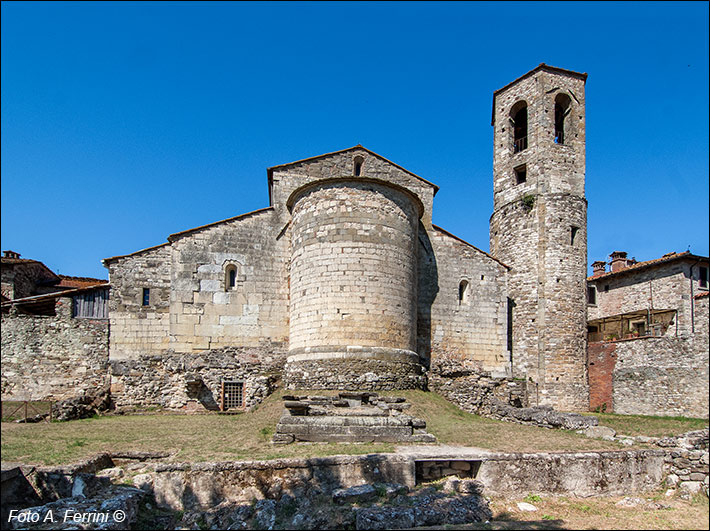La Pieve di Sant'Antonio a Socana
in Casentino, una bella valle Toscana che puoi conoscere in ogni suo dettaglio con questo sito
Italiano
UN TEMPIO AL POSTO DELLA CHIESA
In primo piano, vista d'insieme dell'area archeologica di Socana, dietro, la parte absidale della pieve romanica con il particolarissimo campanile (almeno per la zona casentinese). Quest'immagine ci mostra come la parti basse del muro e dell'abside della chiesa presentino un pietrame molto diverso da quello superiore, praticamente non lavorato, quindi meno pregiato e stabile. Si tratta dei resti della seconda chiesa edificata probabilmente agli inizi del Mille.
Con le prossime pagine andremo a conoscere i particolari di questo prestigioso sito, in primis l'ara etrusca che vediamo davanti all'abside. Ma prima d'addentrarci in questo luogo facciamo un gioco d'immaginazione, ci aiuterà a comprenderlo meglio in ogni suo elemento. Cancelliamo dalla nostra vista la pieve romanica e dietro l'ara immaginiamo una scalinata che sale ad un tempio rivolto verso di noi e addobbato sulle gronde con tante antefisse. Poi è opportuno ricordare che mentre le nostre chiese sono quei luoghi "d'incontro" tra il popolo e Dio, ai tempi etruschi potevano accedere solo i sacerdoti. Il popolo rimaneva fuori dal luogo sacro, in questo caso all'esterno delle mura davanti e ai lati dell'ara ara dove si praticava il sacrificio degli animali.
In the foreground, an overall view of the archaeological area of Socana, behind, the apse of the Romanesque parish church with its very particular bell tower (at least for the Casentino area). This image shows us how the lower parts of the wall and the apse of the church have a very different stone from the upper one, practically unworked, therefore less valuable and stable. These are the remains of the second church probably built at the beginning of the year 1000.
In the next pages we will get to know the details of this prestigious site, first of all the Etruscan altar that we see in front of the apse. But before going into this place, let's play a game of imagination, it will help us understand it better in all its elements. Let's erase the Romanesque parish church from our view and behind the altar imagine a staircase that goes up to a temple facing us and decorated on the eaves with many antefixes. Then it is appropriate to remember that while our churches are those places of "meeting" between the people and God, in Etruscan times only priests could access them. The people remained outside the sacred place, in this case outside the walls in front of and on the sides of the altar where the sacrifice of animals was practiced.













































